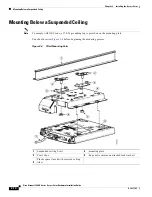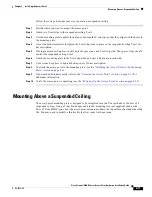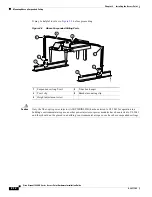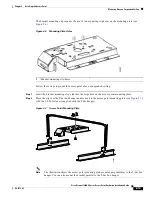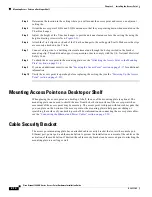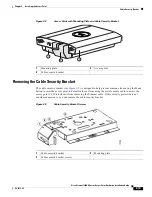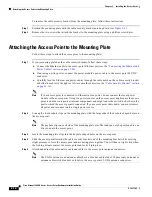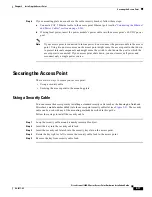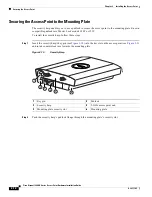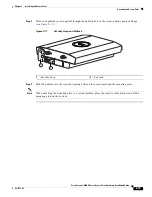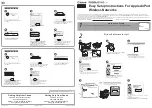
2-4
Cisco Aironet 1240AG Series Access Point Hardware Installation Guide
OL-8371-05
Chapter 2 Installing the Access Point
Basic Installation Guidelines
Basic Installation Guidelines
Because the access point is a radio device, it is susceptible to interference that can reduce throughput
and range. Follow these basic guidelines to ensure the best possible performance:
•
Ensure that a site survey has been performed to determine the optimum placement of access points.
•
For lightweight access points, check the latest release notes to ensure that your controller software
version supports the access points to be installed. You can find the controller release notes by
selecting your controller under Wireless LAN Controllers at this URL:
http://www.cisco.com/en/US/products/hw/wireless/tsd_products_support_category_home.html
•
Ensure that access points are not mounted closer than 20 cm (7.9 in) from the body of all persons.
•
Do not mount the access point within 3 feet of metal obstructions.
•
Install the access point away from microwave ovens. Microwave ovens operate on the same
frequency as the access point and can cause signal interference.
•
Do not mount the access point outside of buildings.
•
Do not mount the access points on building perimeter walls unless outside coverage is desired.
Controller Discovery Process for Lightweight Access Points
The lightweight access point supports these controller discovery processes:
•
DHCP server discovery—Uses DHCP Option 43 to provide controller IP addresses to the access
points. Cisco switches support a DHCP server option. For additional information, refer to the
“Configuring DHCP Option 43 for Lightweight Access Points” section on page G-1
.
•
DNS server discovery—The access point uses the name CISCO-LWAPP-CONTROLLER.<local
domain> to discover the controller IP addresses from a DNS server. Where <local domain> is the
access point domain name.
•
Locally stored controller IP addresses—If the access point was previously associated to a controller,
the IP addresses of the primary, secondary, and tertiary controllers are stored in the access point
non-volatile memory. The process of storing controller IP addresses in access points for later
deployment is called priming the access point. For additional information, refer to the
“Priming
Lightweight Access Points Prior to Deployment” section on page F-1
.
You can also manually configure controller information using CLI commands on new
(out-of-the-box) access points that are not connected to a controller. For additional information refer
to the
“Manually Configuring Controller Information Using the Access Point CLI” section on
page 4-7
.
Cisco recommends that you configure a DHCP server with Option 43 to provide the controller IP
addresses to your access points. Cisco switches provide a DHCP server option that is typically used for
this purpose.





















